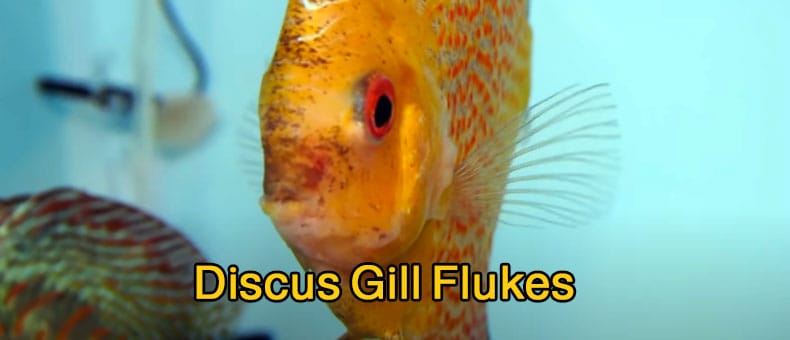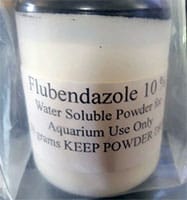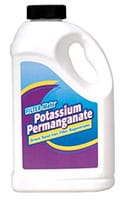
What Is Gill Fluke Disease In Discus?
Discus gill fluke disease is a disease found on the gills of the discus fish, which is caused by small white worm-like parasites, which could be seen only with the aid of a microscope. This disease becomes visible with symptoms such as difficulty in breathing, Discus gills sticking out, bad looking gills. This can be easily taken care of with good aquarium practices.
Table of Contents
- What Is Gill Fluke Disease In Discus?
- What Are The Symptoms Of Gill Flukes?
- Gill Flukes Details And Cause
- How Do You Treat Discus Gill Disease?
- How To Prevent Discus Gill Flukes In The Future?
- Conclusion
What Are The Symptoms Of Gill Flukes?
- Abnormal breathing pattern.
- The presence of yellow dustings or tiny red spots.
- Frequent scratching against anything by the discus fish.
- An alteration on the slime coat.
- Sore inflicted fins.
- Bad looking gills.
- Eye wounds.
- Weight loss
- Skin wounds.
Abnormality In Breathing
Discus rapid breathing can be seen from the water surface as they gasp for oxygen; this is caused when one gill isn’t working primarily due to an inflamed gill tissue causing the discus gills sticking out.
In cases like these, an observation is made to know the duration of the difficulty in breathing fast, if it persists for a longer time frame, you might begin the diagnosis by changing the water or improving the water quality. If it persists afterward, the discus fish could be infected with some discus gill problems.
Weight Loss
Fish easily loses weight when they are faced with health-related issues such as irregular feces discharge or non-specific cases like darker colors. Most often, this is the first sign that is readily visible.
The moment a healthy fish starts excreting stringy and whitish feces, it is a likely symptom of spironucleus or other flagellates.
Eye Wounds
The moment your fish has eye wounds, you will have to look for confirmation from other fishes, if they are having the same problem. Then you will have to trace the likely cause of this.
Once all these are checkmated, if it persists, other symptoms related to an infectious disease such as gill fluke should be looked upon.
Fin Wounds
Fin rot can occur due to injuries sustained by the fish from:
- Transportation.
- Poor water quality.
Usually, when the fin gets injured, it can easily be affected by fungi or bacteria, thereby killing the cells.
Why Is My Discus Breathing Fast?
Breathing difficulty in your discus fish can be seen from the water surface as they gasp for oxygen; this is caused when one gill isn’t working primarily due to an inflamed gill tissue.
In a case like this, an observation is made to know the duration of the difficulty in breathing last, if it persists for a longer time frame, you might begin the diagnosis by changing the water or improving the water quality. If it persists afterward, the discus fish could be infected with a discus gill fluke problem.
Gill Flukes Details And Cause
Discus gill flukes are single genetic trematodes that reproduce without a host. There is a pest that is predominant in water, especially in cichlid water. The adults are about 2mm in length, possessing hooks and anchors. They hatch their eggs within 1-5 days.
When this infectious parasite attacks the discus fish, it will be seen that the discus fish will be breathing hard, often with a single opercle closed.
Fewer flukes are found in adult fish. Most times, juvenile discus fishes are greatly affected by the gill fluke. It is not an abnormal case when a full tank of dime discus fry hangs at the surface of the water and dies off within a couple of days.
The discus gill fluke prevails in deteriorating water bodies because they feed on:
- Skin.
- Mucus.
- Blood.
Gill Flukes Causes
- Egg-laying flukes.
- Trematodes.
- Skin protozoan.
- Deteriorating water.
Below are three treatments available to treat this infection, but only one can be selected to do so.
- Praziquantel, or Prazipro.
- Flubendazole.
- Fluke-Tabs.
The appropriate treatment should improve and clear up the symptoms quickly. Yet, if your aquarium has a substrate, it will be difficult to eradicate the infection completely as the mulm may hinder the parasite eggs from the treatment. Several repeated treatments may be needed to fix this.
If after the treatment has been carried out and there is no improvement with symptoms like white dots on the skin or fin, your fish might have a ciliate or flagellate infection. This can be taking care of by raising the temperature of the tank.
How Do You Treat Discus Gill Disease?
Discus gill fluke disease can be treated by 4 treatment methods which are:
[METHOD1] – Salt Treatment
Standard salt treatment is an aquarium fluke treatment that mainly takes care of the pathogen, but not the fluke.

Praziquantel Vacuum well. Use a slightly rounded teaspoon per 20 gallons. Follow this schedule when treating flukes with Prazi:
Praziquantel Vacuum well. Apply a slightly rounded teaspoon for every 20 gallons. Follow the procedure below when treating discus gill flukes.
- The first day – remove carbon, perform 30% water change with vacuuming, and add Prazi to the tank.
- The second day– add Prazi.
- from day 3 to 5 – do nothing.
- from day 6 and 7 – add Prazi.
- from day 8 – water with vacuuming.
- from day 14 – change water, then add Prazi.
- from day 21 – change water, then add Prazi.
- from day 28 – change water, then add Prazi.
- from day 35 – change water, add carbon, treatment is complete!
[METHOD2] – Wormer Plus Treatment
Wormer Plus treatment is based on the Flubendazole compound, which has been known to treat various discus infections, which include:
- Discus gill flukes.
- Body flukes.
- and intestinal helminths.

It is a temperature friendly treatment. During treatment, other tropical fishes are not affected.
[METHOD3] – Formalin Treatment
The use of formalin has been found to be very useful in the treatment of external and Discus gill parasites.

[STEP1] – You can apply a dose of (1ml or 1 cc per 10 gallons of water)
[STEP2] – Change about half of the water after eight hours after the application of formalin.
[STEP3] – Keep the temperature of the water constant because formalin reduces the oxygen content of the water.
[STEP4] – After this treatment, an observation is needed to see if there is an improvement in breathing or less scratching by the discus fish.
[METHOD4] – Potassium Permanganate Treatment Method
The use of Potassium Permanganate in the treatment of discus gill fluke is also effective. During the giving of treatment, ensure not to discontinue quickly.

This is done to terminate any larva that may have survived, which may lead to a continuing in the production of the gill flukes in the discus fish.
Follow the below proper steps to treat your Discus from Gill Flukes using Potassium Permanganate:
- Perform the treatment only while you are available all-time at your aquarium place (just in case anything happens you can rectify).
- Prepare a solution outside the tank by combining (2 grams) of Potassium Permanganate to (1 liter) of water in a small cup or pout.
- Turn off your Tank heater all time while treatment is in progress.
- Use (1 ml) of the solution to every (1 liter) size of your aquarium, meaning, if your aquarium is (100 liter in size) you should pour in (100 ml of solution).
- When you add the PP Solution, wait from (5 – 20 minutes) till the water color changed from pink to coffee color.
- Perform 85% water change of your tank.
Here is a video of how to treat Discus Gill Flukes using Potassium Permanganate
How To Prevent Discus Gill Flukes In The Future?
- Wormer Plus should be used – as a monthly preventative measure.
- Quarantine method – To prevent gill flukes from contaminating your aquarium, it is needed to quarantine any new fish. The quarantine period should be at least 3-5 weeks. You need to ask the seller if the fish has been quarantined before. After the quarantine period is over and the fish is healthy enough then it could be introduced into the aquarium with other discus fish
- Reduction in OverCrowding – Overpopulation in the aquarium can promote gill flukes, skin flukes. If these flukes can reproduce, it is transmissible from one fish to another by the method of contact.
- The Use Of A Separate Set Of Tools – The equipment used for a quarantined aquarium should not be used for an aquarium whose health condition has been certified, okay. Infections such as skin protozoan move quicker than infections by skin flukes.
For fishes with difficulty in breathing as one of its symptoms, the following care could be followed:
- Always change about half the total volume of water in the aquarium. It is advisable to carry out this practice as often as possible, perhaps twice daily. Continue this practice until there are no more symptoms.
- The use of neutralizers and filter materials can be employed to deactivate poisonous substances in the water. Though no substitute for a frequent changing of the water yet both can be used together.
- The need to regulate the PH level of the aquarium is highly needed if the PH value is above 7, it has to be brought down. Sometimes, the presence of ammonia (salt) could be responsible, so if it is the cause, it has to be reduced else, the biological filtration in the aquarium will be damaged
- The use of an oxygen test kit is very much needed in testing the oxygen level of the aquarium. A regular oxygen level test should be taken to know when a moderate or significant oxygen drop has occurred. If the oxygen level of the aquarium is within 2-3 mg/l, it will become difficult for your discus fish to breathe easily. While you pump in the air into the aquarium to enhance the oxygen level, an ongoing finding should be made to determine other possible causes.
Conclusion
Aquatic lives such as the discus fish are generally susceptible to bacteria and fungi infections. In order to have a healthy aquarium, both preventive and treatment measures must be carried out from the time interval. Also, a regular water change should be on top of the list for both treatment and preventive measures.


hello good afternoon, i am currently bathing my discus permanganate for an hour. I know that I must repeat the baths, my question is how many days apart ?? example: day 1 do the bath, which day should I do next ?? I am very grateful for your help and I am very happy and grateful to have found this website. wishes for much health.
Hi Ricardo,
I have added the Gill Flukes treatment steps in the article using the Potassium Permanganate, for your question I have added a note under the steps for how often the treatment should be carried out.
Hope this will help you treat your Discus Fish.
Have a good day.
It’s truly a great and helpful piece of info. I am glad that you just shared this useful info with us. Please stay us up to date like this. Thanks for sharing.
for sure thanks.
I have lost dome fishes because of gill flukes and I tried so many treatments with no good results except for prazipro. . any one have dealed with this illness before?